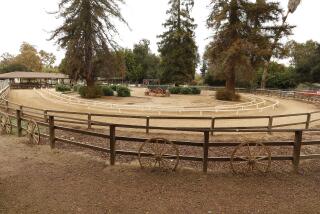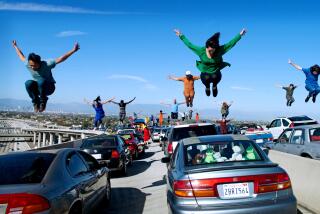Making It Merry Again : Griffith Park Carrousel Being Restored to Original State
Rosemary Deasy walked over to one of her favorite horses--small and black, with a wild expression formed by donkey jaws and goat-like eyes. It was badly weathered, yet still splendid in a breastplate of beveled jewels. Deasy stroked it lovingly under its neck.
“ You don’t want to be in somebody’s living room, do you?” she cooed.
The horse kept its own counsel, as it has ever since a renowned carrousel builder named Charles Looff carved it out of solid wood before the turn of the century. But to Deasy, the answer was obvious and the question was frightening.
Worried that Griffith Park’s historic but badly tarnished carrousel might go the way of most of America’s merry-go-rounds--closed and auctioned off, one horse at a time--Deasy and her husband, Warren, have purchased the carrousel and begun an ambitious five-year project to restore the tattered collection of 67 wooden horses.
They’re not the first.
A decade ago, two other preservationists, motivated by the same fears, bought the 67-horse carrousel from the family that put the carrousel in Griffith Park in 1936. They planned to repair the horses, restore the thundering band organ and return the carrousel to its original glitter.
Finally, last year, the preservationists gave up and went looking for a buyer who would promise to maintain the carrousel instead of selling it off piecemeal.
It was the deal the Deasys had been waiting for.
“We’re automatic musical instrument freaks,” explained Warren Deasy, a 43-year-old television commercial producer, ticking off such possessions as a 1906 “violano” that uses paper rolls and magnetic devices to automatically play not merely a piano but also a violin, and a Victorian grandfather clock that plays tunes from a 15-inch disc on the hour.
The couple have continued the carrousel’s unbroken schedule of operation, running the four-minute, 14-m.p.h. journey on weekends and days when school is not in session. Soon they plan to begin removing and repairing each four-horse row of the carrousel, row by row. Badly chipped paint, untouched since the 1950s, will be stripped to the wood. Each horse will be sanded, patched, filled, glued, rewired, given a new horsehair tail, painted and jeweled to its original specifications.
The Deasys expect the going to be painfully slow. Rosemary Deasy, a 42-year-old commercial artist, plans on handling much of the work herself and figures she can finish off a row every four months or so in between her professional responsibilities. The couple say they sold their home and their two business offices to finance the purchase and reconstruction.
“This carrousel deserves to be done beautifully,” Rosemary Deasy said. “A lot of people think we’re crazy to put this much work into it. But I want it to look the way it used to. That’s what this machine is supposed to look like.”
Her husband, beaming like Santa Claus, added, “On Saturdays at 11 we start up the band organ, and from all over the park you can see the children dance down the hill” into the bowl where the 50-cent-a-ride is located, two miles into the park from the Los Feliz Boulevard-Riverside Drive entrance. “It’s just so neat. It’s like the Pied Piper.”
The Deasys said they expect to spend about $350,000 on repairing the horses and the ornate interior of the carrousel building and hope to recruit an army of volunteers. They should be able to make a profit from operating the ride, according to Shirley Darwick, a concession analyst for the city Department of Recreation and Parks, which charges the Deasys 12% of gross revenues to operate on city property.
Constructed in 1926 by Spillman Engineering, a major manufacturer of carrousels, the carrousel was initially operated in San Diego, then moved to Griffith Park a decade later. Sixteen of its horses were carved by Looff, one of a handful of immigrants who brought the European popularity of the carrousel to America in the late 1800s. It is believed to be the last full-size Spillman in operation.
The Griffith Park merry-go-round was built in an era when thousands operated in the United States, but today few more than 200 operate, including nine in Southern California. The Depression killed the manufacturers, the ride ceased being a ritual of childhood and in the 1970s carrousel horses suddenly became popular with folk art collectors. Carrousel owners made huge profits simply by buying a machine and tearing it apart.
“It’s very heartbreaking,” Rosemary Deasy said.
Their struggle against that trend has produced some heartwarming moments, the couple said.
For example, when they were planning to replace the badly rusted paintings on the tin semicircles that line the crown of the carrousel, a relative of the original owner found some canvas paintings rolled up in a barn. They turned out to be copies of the crown paintings that had been made in the 1950s by a dying Nathan Boleus--the itinerant circus and carnival painter who had painted the Griffith Park carrousel with marvelous subtlety in the ‘30s.
Last year, Warren Deasy said, he was trying to figure out how to replace two of the 45-pound mirrored shields that also decorate the carrousel’s crown when a small boy showed up lugging one of them.
“He said his mother had found the shield in the park a long time ago and told him to bring it back when she heard there was a new owner,” Deasy said. “Wonderful things like that just seem to happen. There’s an awful lot of love connected with this place.”
More to Read
The biggest entertainment stories
Get our big stories about Hollywood, film, television, music, arts, culture and more right in your inbox as soon as they publish.
You may occasionally receive promotional content from the Los Angeles Times.









